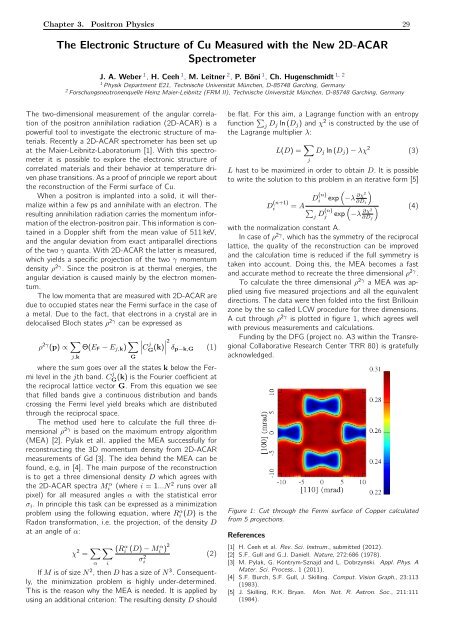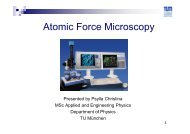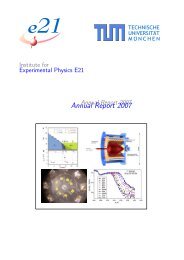Annual Report 2011 / 2012 - E21 - Technische Universität München
Annual Report 2011 / 2012 - E21 - Technische Universität München
Annual Report 2011 / 2012 - E21 - Technische Universität München
Create successful ePaper yourself
Turn your PDF publications into a flip-book with our unique Google optimized e-Paper software.
Chapter 3. Positron Physics 29<br />
The Electronic Structure of Cu Measured with the New 2D-ACAR<br />
Spectrometer<br />
J. A. Weber 1 , H. Ceeh 1 , M. Leitner 2 , P. Böni 1 , Ch. Hugenschmidt 1, 2<br />
1 Physik Department <strong>E21</strong>, <strong>Technische</strong> Universität München, D-85748 Garching, Germany<br />
2 Forschungsneutronenquelle Heinz Maier-Leibnitz (FRM II), <strong>Technische</strong> Universität München, D-85748 Garching, Germany<br />
The two-dimensional measurement of the angular correlation<br />
of the positron annihilation radiation (2D-ACAR) is a<br />
powerful tool to investigate the electronic structure of materials.<br />
Recently a 2D-ACAR spectrometer has been set up<br />
at the Maier-Leibnitz-Laboratorium [1]. With this spectrometer<br />
it is possible to explore the electronic structure of<br />
correlated materials and their behavior at temperature driven<br />
phase transitions. As a proof of principle we report about<br />
the reconstruction of the Fermi surface of Cu.<br />
When a positron is implanted into a solid, it will thermalize<br />
within a few ps and annihilate with an electron. The<br />
resulting annihilation radiation carries the momentum information<br />
of the electron-positron pair. This information is contained<br />
in a Doppler shift from the mean value of 511 keV,<br />
and the angular deviation from exact antiparallel directions<br />
of the two γ quanta. With 2D-ACAR the latter is measured,<br />
which yields a specific projection of the two γ momentum<br />
density ρ 2γ . Since the positron is at thermal energies, the<br />
angular deviation is caused mainly by the electron momentum.<br />
The low momenta that are measured with 2D-ACAR are<br />
due to occupied states near the Fermi surface in the case of<br />
a metal. Due to the fact, that electrons in a crystal are in<br />
delocalised Bloch states ρ 2γ can be expressed as<br />
ρ 2γ (p) ∝ ∑ j,k<br />
Θ(E F −E j,k ) ∑ G<br />
∣<br />
∣C j G (k) ∣ ∣∣<br />
2<br />
δp−k,G (1)<br />
where the sum goes over all the states k below the Fermi<br />
level in the jth band. C j G<br />
(k) is the Fourier coefficient at<br />
the reciprocal lattice vector G. From this equation we see<br />
that filled bands give a continuous distribution and bands<br />
crossing the Fermi level yield breaks which are distributed<br />
through the reciprocal space.<br />
The method used here to calculate the full three dimensional<br />
ρ 2γ is based on the maximum entropy algorithm<br />
(MEA) [2]. Pylak et all. applied the MEA successfully for<br />
reconstructing the 3D momentum density from 2D-ACAR<br />
measurements of Gd [3]. The idea behind the MEA can be<br />
found, e.g, in [4]. The main purpose of the reconstruction<br />
is to get a three dimensional density D which agrees with<br />
the 2D-ACAR spectra Mi α (where i = 1...N 2 runs over all<br />
pixel) for all measured angles α with the statistical error<br />
σ i . In principle this task can be expressed as a minimization<br />
problem using the following equation, where Ri α (D) is the<br />
Radon transformation, i.e. the projection, of the density D<br />
at an angle of α:<br />
χ 2 = ∑ α<br />
∑<br />
i<br />
(R α i (D)−Mα i )2<br />
σ 2 i<br />
(2)<br />
If M is of size N 2 , then D has a size of N 3 . Consequently,<br />
the minimization problem is highly under-determined.<br />
This is the reason why the MEA is needed. It is applied by<br />
using an additional criterion: The resulting density D should<br />
be flat. For this aim, a Lagrange function with an entropy<br />
function ∑ j D j ln(D j ) and χ 2 is constructed by the use of<br />
the Lagrange multiplier λ:<br />
L(D) = ∑ j<br />
D j ln(D j )−λχ 2 (3)<br />
L hast to be maximized in order to obtain D. It is possible<br />
to write the solution to this problem in an iterative form [5]<br />
D (n+1)<br />
i<br />
= A<br />
D (n)<br />
i exp<br />
∑j D(n) j exp<br />
) (−λ ∂χ2<br />
∂D i<br />
(<br />
−λ ∂χ2<br />
∂D j<br />
) (4)<br />
with the normalization constant A.<br />
In case of ρ 2γ , which has the symmetry of the reciprocal<br />
lattice, the quality of the reconstruction can be improved<br />
and the calculation time is reduced if the full symmetry is<br />
taken into account. Doing this, the MEA becomes a fast<br />
and accurate method to recreate the three dimensional ρ 2γ .<br />
To calculate the three dimensional ρ 2γ a MEA was applied<br />
using five measured projections and all the equivalent<br />
directions. The data were then folded into the first Brillouin<br />
zone by the so called LCW procedure for three dimensions.<br />
A cut through ρ 2γ is plotted in figure 1, which agrees well<br />
with previous measurements and calculations.<br />
Funding by the DFG (project no. A3 within the Transregional<br />
Collaborative Research Center TRR 80) is gratefully<br />
acknowledged.<br />
Figure 1: Cut through the Fermi surface of Copper calculated<br />
from 5 projections.<br />
References<br />
[1] H. Ceeh et al. Rev. Sci. Instrum., submitted (<strong>2012</strong>).<br />
[2] S.F. Gull and G.J. Daniell. Nature, 272:686 (1978).<br />
[3] M. Pylak, G. Kontrym-Sznajd and L. Dobrzynski. Appl. Phys. A<br />
Mater. Sci. Process., 1 (<strong>2011</strong>).<br />
[4] S.F. Burch, S.F. Gull, J. Skilling. Comput. Vision Graph., 23:113<br />
(1983).<br />
[5] J. Skilling, R.K. Bryan. Mon. Not. R. Astron. Soc., 211:111<br />
(1984).




